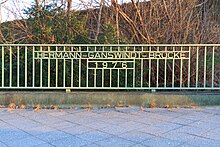Hermann Ganswindt
Johann Hermann Ganswindt (born June 12, 1856 in Voigtshof near Seeburg , Warmia , † October 25, 1934 in Berlin ) was a German inventor and rocket pioneer whose apparatus (steerable airship , helicopter , explosion engine ) was ahead of its time.
youth
He was the son of the mill owner Carl Florian Ganswindt and his wife Euphrosine nee Dost. Ganswindt was noticed in his early youth because of his interest in technology. As a schoolboy he developed a freewheel for bicycles, which he later produced himself in Berlin-Schöneberg . At the insistence of his parents, he took up law studies in Zurich and Leipzig; after his military service he enrolled at the Berlin university, where he was de-registered because he did not attend lectures.
Space proposals
After 1880, Ganswindt developed concepts for a spacecraft that was to be propelled by dynamite explosions based on the recoil principle. He envisaged a two-stage concept; the spacecraft was to be towed upward by a carrier. To this end, he developed a helicopter from 1884.
On May 27, 1893, he gave a public lecture in the Berlin Philharmonic in which he presented his concept of a world vehicle . In July 1901 the first flight of his helicopter took place in Berlin-Schöneberg , which was probably the first ever powered flight by humans. A film by the Skladanowsky brothers is missing. Ganswindt had installed a safety bar and was therefore accused of fraud in 1902 and taken into custody for eight weeks. He was released after a flight demonstration in view of his proven innocence, but fell through the accusations into business ruin.
Historical location
Ganswindt was a visionary who seems to be decades ahead of his time. His contemporaries did not yet recognize the importance of his ideas. In old age he was still in contact with the rocket pioneer Hermann Oberth , who also gave him knowledge of Robert Goddard's work. He was also still in contact with Max Valier .
Honors and continued work
In Berlin-Schöneberg since 1976 that reminds Hermann Ganswindt Bridge at Ganswindt. The International Astronomical Union named the lunar crater Ganswindt and the Amundsen-Ganswindt Basin in his honor. Ganswindt's enthusiasm for space travel was carried over to one of his sons, who worked on the American moon flight program under Wernher von Braun . His daughter was the physicist Isolde Hausser .
The principle of a spaceship powered by gunpowder explosions was planned by NASA for the Orion project (1957-1965) as a nuclear pulse drive .
Publications
- The steerability of the aerostatic airship: presented in common with detailed calculations and drawings . Gsellius, Berlin 1884.
- The Last Judgement. Inventions by Hermann Ganswindt . 2nd increased edition with illustrations and reports. Self-published, Schöneberg near Berlin 1899.
literature
- Maré Stahl: a brother of Icarus. The life of Hermann Ganswindt . In: Scherl's Magazin Sept. 9/1933, Berlin 1933, pp. 516-521.
- Willy Ley : Hermann Ganswindt "inventor" . In: Technik für Alle , Volume 26, 1935, Issue 4, pp. 106-108.
- Heinz Gartmann : dreamers - researchers - designers. The adventure of space travel . Econ Verlag, Düsseldorf 1955 (among others on Konstantin E. Ziolkowski , Robert Goddard , Hermann Oberth , Max Valier , Rudolf Nebel , Reinhold Tiling , Johannes Winkler , Eugen Sänger , Helmut von Zborowski , Wernher von Braun , Hermann Ganswindt, 336 pages, 40 plates ).
- Ilse Essers : Hermann Ganswindt. Pioneer of space travel with his world vehicle since 1881. VDI, Düsseldorf 1977, ISBN 3-18-150026-7 .
- Marin Majica: The man who flew and went to jail for it . In: Berliner Zeitung , April 2, 2004
Web links
- Ganswindt, Hermann (1856–1934) . In: The Encyclopedia of Astrobiology, Astronomy, and Spaceflight
- Falko Hennig: To Hermann Ganswindt . translucent impact , 06/2002
- The rocket pioneers . Wissen.de, accessed on October 7, 2010
- The Edison von Schöneberg. (PDF; 71 kB) (No longer available online.) Archived from the original on March 22, 2011 ; accessed on May 15, 2015 .
- Patent No. 29014. Airship with steering device. (PDF; 711 kB)
Individual evidence
- ↑ Ganswindt: The Last Judgment, p. 116
- ^ Letter from Ganswindt to Max Valier , 1925
| personal data | |
|---|---|
| SURNAME | Ganswindt, Hermann |
| ALTERNATIVE NAMES | Ganswindt, Johann Hermann |
| BRIEF DESCRIPTION | Inventor and rocket pioneer |
| DATE OF BIRTH | June 12, 1856 |
| PLACE OF BIRTH | Voigtshof near Seeburg , Warmia |
| DATE OF DEATH | October 25, 1934 |
| Place of death | Berlin |


